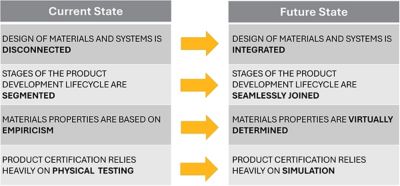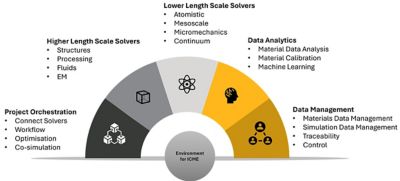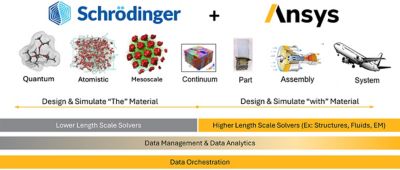-
-
Access Free Student Software
Ansys empowers the next generation of engineers
Students get free access to world-class simulation software.
-
Connect with Ansys Now!
Design your future
Connect with Ansys to explore how simulation can power your next breakthrough.
Countries & Regions
Free Trials
Products & Services
Learn
About
Back
Products & Services
Back
Learn
Ansys empowers the next generation of engineers
Students get free access to world-class simulation software.
Back
About
Design your future
Connect with Ansys to explore how simulation can power your next breakthrough.
Free Trials
ANSYS BLOG
May 7, 2024
Ansys and Schrödinger Partner to Enable Multiscale Simulation
Product development teams can achieve a new level of design optimization via simulation at the nano, micro, and macro scales
As product development teams face increasingly complex challenges — including the need for greater sustainability — there’s a growing awareness of the critical contributions made by materials. Many of our most pressing engineering challenges, from renewable energy grids to green transportation, rely on identifying or creating the right materials.
Historically, materials discovery, material production, and product engineering teams have largely operated independently, with a small degree of knowledge exchange through top-down product driven material requirements and bottom-up material selection. This gap has been one of the key limiters of bringing new material into commercial products.
Leading scientific agencies, including NASA, have long recognized that the path to accelerate advancements in new engineering technologies will require rapid material identification integrated with product development. In principle, this would require the engineering community to move from its current segmented, physical test driven approach in designing materials and systems to a more integrated approach relying heavily on numerical analysis platforms.

NASA’s 2040 vision outlining the current and future state of integrated, multiscale modeling and simulation of materials and systems.
The path to achieve this vision is concisely named integrated computational material engineering (ICME). It covers a wide range of solutions and products that are necessary to enable this transformation. Specifically, there is a need for computational mechanics solvers at different scales to understand how material constituents and structure-property relationships affect their physical properties and product responses under varying operating conditions. In addition, there are new technology drivers like machine learning (ML), which enable data analytics to construct mathematical structure-property relationships.
More broadly, there is a need for integrated project orchestration from solvers predicting materials behavior to those predicting physical product responses. Given the breadth of materials and operating conditions, a material data management platform is essential for large organizations and industry/academic consortiums on this journey. All of these emerging needs in terms of platforms and solutions for virtual verification and validation of material performance applied to physical systems require significant partnerships across industry, academia, and national laboratories.

Integrated Ansys and Schrödinger solutions address material-to-system challenges.
With this vision of ICME as a primary driver, Ansys and Schrödinger have formed a partnership to address material-to-system challenges. Schrödinger has provided solutions for predictive material discovery, optimization, and materials analytics for over three decades. The combined product portfolio and integration will bring the vision of ICME closer to reality across technologies including next generation batteries, consumer products, electronics, and transportation domains. For industry, this partnership provides potential for several transformative outcomes including sustainable materials driven products, screening a large spectrum of materials, predictive material performance for in-service conditions, and materials to products circularity.

An example of an integrated computational material engineering (ICME) workflow integrating Schrödinger and Ansys solutions.
As an initial demonstration of the combined value of this partnership, Ansys and Schrödinger have developed a solution for predictive performance of fiber reinforced composites that are widely employed across aerospace and defense, automotive, and energy companies. The study shows predictive material screening and selection for polymer resins under different conditions. The resin properties are upscaled through a hierarchical multiscale modeling framework into lamina level properties with additional understanding of process induced material variabilities and key structure-property relationships. Finally, the lamina properties are upscaled into composite laminate applied to an intended physical system application.